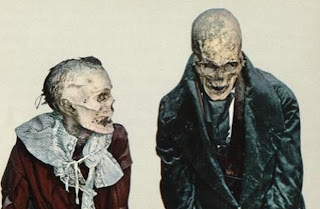"Death where is your sting? Grave where is your victory?"
1 Corinthians 15
Visitors to Palermo, Italy might (in search of a more bizarre touristic experience) be tempted to visit the city's Capuchin Catacombs - a place where several thousand of its late residents have been mummified and laid to rest. The practice began as far back at 1599 and slowly grew in popularity - so much so that it became common practice to stipulate in one's will the clothing and pose in which one wished to be put on display.
Two satisfied occupants of Palermo's Capuchin Catacombs
The ancient Jews had a similar disposition to the treatment of their dead. Large caverns were hewn laboriously from the native rock to create multi-chambered resting places for whole families. Once such places were full, space was made by re-locating the bones of earlier ancestors to containment facilities known as ossuaries. Like the residents of Palermo, the emphasis was not just on giving the dead the best send-off possible but on ensuring that they were well remembered on this side of eternity too.
But this was only the preserve of the very rich. Poor Jews were forced to bury their dead in the ground and the bodies of executed people were often disposed of in un-marked graves. No dignified send off for them - no monuments for posterity.
This brings us to the story of Joseph of Arimathea, the man who recovered the body of Jesus in order to give it a proper burial in a grave of his own. While the story is pretty well known, there are aspects to it which call for a second look.
Firstly, I find it remarkable that this man, ostensibly a member of the ruling group which had conspired to execute Jesus, would actively seek an audience with the very man who had passed sentence. After the unspeakable brutalities of the day - from the vicious scourging to the very public execution itself this was a bold move if ever there was one. As it says in Mark's gospel:
"Joseph, he of Arimathea, noble and honorable in rank and a respected member of the council (Sanhedrin), who was himself waiting for the kingdom of God, daring the consequences, took courage and ventured to go to Pilate and asked for the body of Jesus"
Not for the first time that day did the sound of hammering resound over Jerusalem - only this time it was metaphorical and it signalled the nailing of a brave and devoted man's colours to the proverbial mast.
Secondly, (beyond securing the body), it was Joseph who joined fellow Sanhedrin member Nicodemus in the extravagant purchase of myrrh and aloe to ensure that Jesus received the type of embalming fitting of family member. Indeed, as commentator R.J. Miller points out: "it is almost as if Joseph is in effect bringing Jesus into his family".
Besides the act being both courageous and consistent with Jewish traditions, I find it highly prophetic too. From Joseph we see the radical alteration of earthly plans to make space for the Saviour. In making such space, he invites Christ to come in alongside his hopes and dreams, his desires for status and reputation. The story is a reminder that following Christ is not just about building a monument to my past but about securing my future in his Kingdom too.
Perhaps no-one saw this as clearly as the thief crucified alongside Jesus. Forced into a lingering retrospection of a slow and painful death, this man knew his life was unlikely to be remembered (not for the right things anyway). More than likely there were no relatives to mourn him, no-one to place him in the sort of grave Jesus would end up in. In all likelihood his mortal remains would end up on the dung-heap. In a moment of extreme poignancy he asks "remember me when you enter your kingdom"
Perhaps not surprising then that the angel at the Resurrection tells his followers: "why do you seek the living among the dead?"

No comments:
Post a Comment